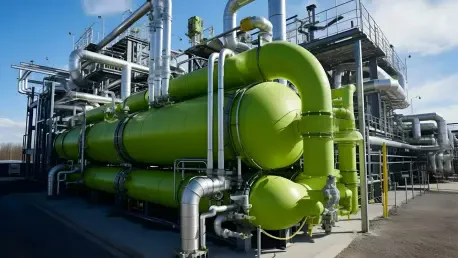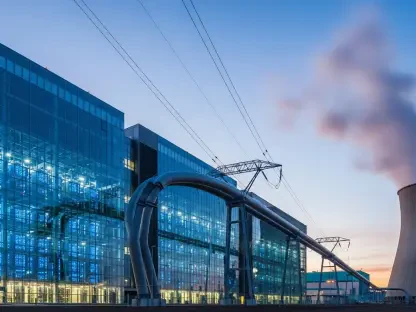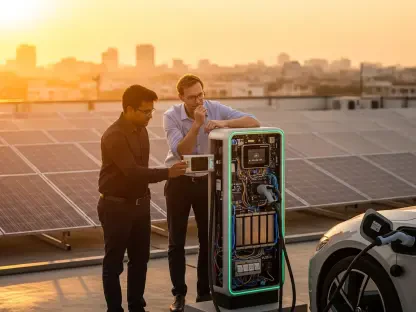Emerging as a beacon of sustainable advancement, the production of green hydrogen promises to transform the global energy landscape amid escalating efforts to combat climate change. InterContinental Energy (ICE), an Australian company, has unveiled the innovative P2(##)Node system, revolutionizing the methodology by directly connecting renewable energy sources to hydrogen production units. This progressive approach signifies a significant step in reducing the inefficiencies and high costs traditionally associated with widespread electricity transmission. As the world grapples with the urgent need to decarbonize, ICE’s pioneering technology offers a timely and compelling solution.
Core Components of Green Hydrogen Systems
The P2(##)Node elegantly simplifies energy production by placing hydrogen generation modules directly at renewable sites, such as wind and solar farms. This direct connection eliminates the need for long-distance power lines, substantially cutting energy losses and enhancing system efficiency. By addressing the constraints of remote areas with underdeveloped power grids, this modular setup provides a powerful alternative to conventional centralized models. Integrated seamlessly into these renewable installations, the P2(##)Node allows for more sustainable operations and significantly reduces associated building expenses.
The system’s incorporation into major projects, like the Western Green Energy Hub, exemplifies its potential to support large-scale hydrogen production efficiently. Collaborative efforts with partners CWP and Mirning Green Energy are key to achieving these ambitious projects, with the anticipated surplus of clean energy promising to spur job creation and attract investment. Such endeavors are a testament to the versatility and potential of ICE’s technology to contribute to broader emissions reduction targets.
The Cutting-Edge Features and Innovation
At the heart of the P2(##)Node system are its hydrogen production modules, which represent a leap forward in enhancing the scalability and affordability of green hydrogen. These modules demonstrate robust performance metrics, enabling cost-effective operation and contributing to competitive production rates. By leveraging locally available renewable resources, the system can mitigate some of the common obstacles that have historically hindered hydrogen scalability.
A significant aspect of the P2(##)Node is its seamless integration with renewable energy, particularly in locales rich with opportunities for wind and solar expansion. This tight-knit integration allows for a more reliable and consistent production cycle, reducing dependency on fluctuating grid operations.
Current Industry Trends and Technological Advancements
In the green hydrogen industry, several transformative trends are shaping its future trajectory. A notable shift is the increasing emphasis on localizing hydrogen production to maximize renewable resource utilization. The modular nature of ICE’s system represents a noteworthy response to this trend, promising cost reductions and operational efficiency gains that are likely to capture significant market interest.
Simultaneously, technological innovations are refining the processes involved in hydrogen storage and distribution. As these advancements are adopted, the scope of ICE’s P2(##)Node and similar technologies will likely expand, furthering the push toward a greener global energy grid. Forward-thinking solutions like this underline a broader industry movement focused on enhancing infrastructure to support hydrogen’s vast potential.
Integration and Practical Applications Across Sectors
The versatility of the P2(##)Node allows it to be effectively applied across various sectors requiring large energy inputs. Sectors like steelmaking and polymer production heavily benefit from implementing these systems, harnessing the power of green hydrogen to meet their immense energy needs without resorting to carbon-rich sources. The maritime and aviation industries also stand to gain, with green hydrogen positioning itself as a viable and sustainable alternative to traditional fuels.
Furthermore, ICE’s system addresses complex challenges in manufacturing fertilizers and other agriculture-related industries, where it promises to offer cost-effective, environmentally-friendly solutions. By facilitating the production of green ammonia, the P2(##)Node is an indispensable ally in efforts to industrialize decarbonization globally.
Challenges to Mass Adoption and Future Directions
Despite its promise, several hurdles impede the widespread adoption of green hydrogen technology. Regulatory complexities and market dynamics present formidable challenges to its development. ICE and similar firms are actively engaged in resolving these issues, working alongside regulatory bodies to create an accommodating landscape conducive to further innovation.
Advancements in storage facilities, supported by legislative efforts, hold the key to overcoming existing challenges in transport logistics. As solutions to these bottlenecks are explored and implemented, green hydrogen systems like the P2(##)Node will likely gain momentum, fostering extensive adoption across industries worldwide.
Looking Ahead
This innovative technology is on the cusp of notable advancements, opening up prospects for breakthroughs in how green hydrogen integrates into the global energy framework. With continued investment and research, the prospects for green hydrogen’s scalability and affordability are promising. Anticipated developments will likely accelerate renewables adoption, thus reducing dependence on fossil fuels. As society becomes increasingly aware of the need for transformative energy solutions, the impact of green hydrogen systems could reshape economic and environmental landscapes globally. The ripple effect of ICE’s system and similar technologies is poised to create a burgeoning industry, aligning with global goals for sustainable development.
Final Assessment
In conclusion, green hydrogen systems, epitomized by ICE’s P2(##)Node, have demonstrated substantial potential in providing clean energy solutions. The introduction of modular, site-direct hydrogen production marks a major advancement in addressing inefficiencies traditionally linked to long-distance electricity transmission. By integrating seamlessly with renewable resources, the P2(##)Node has emerged as a vital tool in reducing the costs and increasing the operational efficiency of hydrogen production. Moving forward, the continued evolution of these systems holds considerable promise for sustainable industrial applications, steering the world closer to a net-zero future. Continued commitment to innovation and market adaptation will be essential for realizing the full benefits of this revolutionary technology.









